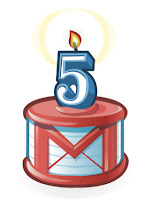 It was five years ago yesterday that Gmail launched by giving out a gig. Back then, a typical webmail account could only store about five megabytes of mail. It's hard to remember what those days were like, considering that today, you can send a single 20 megabyte attachment, four times the size of an entire webmail account from 2004. A gigabyte of online storage may have been what got a lot of people to give Gmail a try, but changes to the email experience — like search, labels, conversation view, and strong spam protection — seem to be what kept people around.
It was five years ago yesterday that Gmail launched by giving out a gig. Back then, a typical webmail account could only store about five megabytes of mail. It's hard to remember what those days were like, considering that today, you can send a single 20 megabyte attachment, four times the size of an entire webmail account from 2004. A gigabyte of online storage may have been what got a lot of people to give Gmail a try, but changes to the email experience — like search, labels, conversation view, and strong spam protection — seem to be what kept people around.The engineers who created Gmail were frustrated with the existing email solutions, and wanted to build a better tool for people who got a lot of mail, which meant rethinking everything from the ground up. They built an architecture that was a combination of HTML and JavaScript (this later became known as AJAX), which offered a smoother, faster interface. And they designed Gmail with the most demanding users in mind — Googlers who got hundreds of messages each day and power users with broadband connections, back when 56k modems were still the norm.
The last 5 years have brought about a lot of change, and Gmail is now more than just mail. We added chat, and then video chat. We've invested in under-the-hood changes that allow for the rapid development that's been happening lately in Gmail Labs — 43 experimental features in 43 weeks including tasks, offline, undo send, and even some silly stuff. What started as internal email for Google employees is now used by more than a million companies and tens of millions of people in 52 languages. And one gigabyte doesn't feel like very much space anymore.
Today's email problems are different than the problems people had five years ago, and Gmail's most demanding users continue to push it to its limits. We're getting more mail and communicating in more ways than ever before. Web browsers are getting faster and offering functionality that people could only dream of in 2004. We expect the changes over the next five years to be even more radical than those of the past five. We're already getting excited about some new stuff we're testing internally, and we'll keep you updated on our progress on the Gmail Blog.
Announced by Todd Jackson, Gmail Product Manager

